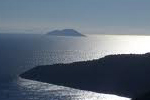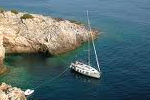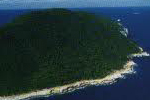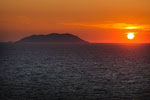Svetac, the island of Zankie's and Elenoa's falcons
SVETAC, THE ISLAND ZANKIJEVIH AND ELEONOA FALCON, ST. ANDREW (Saint), 43 ° 01 'N, 15 ° 44 E, an island on the high seas, 14.5 NM west of Komiža area 4.6 km2, coastal length of 12 km. The highest peaks are Hair (316 m) and Standarac (307 m) while the deep waters around the island and up to 100 m. The island is covered with dense Mediterranean vegetation - maquis and forests of Aleppo pine and coastal oak, which in places outside the beaten path impassable. Coasts of the islands are mostly steep and rugged; in some places open in the caves, some of which, one part of the sea, were the abode of the Mediterranean monk seal (the Holy One ... and once had its sirens).
High on the cliffs, and a Svetac on the rocks nearby islands Kamika,
nests with a rare and protected birds of the family Falconidae,
Eleonora's Falcon (Falco eleonorae, Falco della regina). Despite the
inaccessibility of the island, discovered the ruins, was inhabited
since prehistoric times and has always been an important point
terrestrial navigation route from Monte Gargano (Italy), via
Palgruže to the eastern shores of the Adriatic, and vice versa - the
Straits of Otranto. The importance of the position of the islands in
these waterways by the fact that the charts of the time portrayed
larger than it really is . Today would be the way of Otranto by St.
Andrew's, Visa, Palagruža the Gargano peninsula could call Diomedes
navigation route because they are devotees of the cult Diomedic left
their marks on all the above points .
On the southeast side of the island is one of the few bays in which
the family home Zanki family, which lives on this island for 250
years and is its sole owner. At St. Andrew's was built in the XVII
century church of the saint for which the island is named.
Benedictines on the island leaving a trace of his residence, on the
fertile plains Poje (200 m above sea level) remains of the convent
and chapel, about which there should be a cemetery, but all this is
now preserved only in fragments, because time is inexorable in its
extermination . But there are still only stories and legends such as
the Illyrian Queen - warriors, Teuta, who had a stronghold - a tower
on a cliff on the eastern side of the island, where he spent the
time - at ease in his shelter, resting from warfare or rather,
countdown difficult days of her loneliness, banished and disgraced,
left only memories. This island is strong and harsh beauty that
slowly but surely wins the man, making him the servant, not master,
as evidenced by bloody blisters on the hands of those who have come
up with this island and its sea, caught in the grips. So it was used,
and so it is today.







